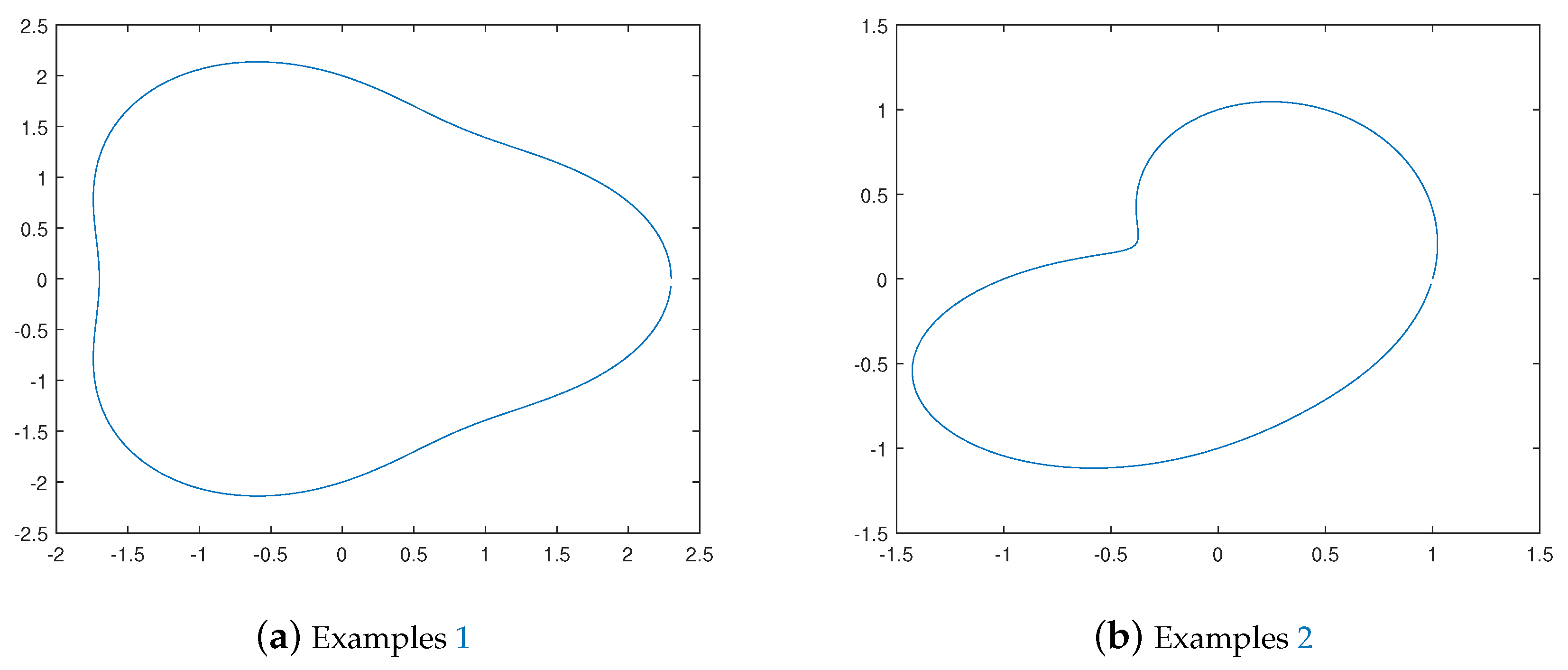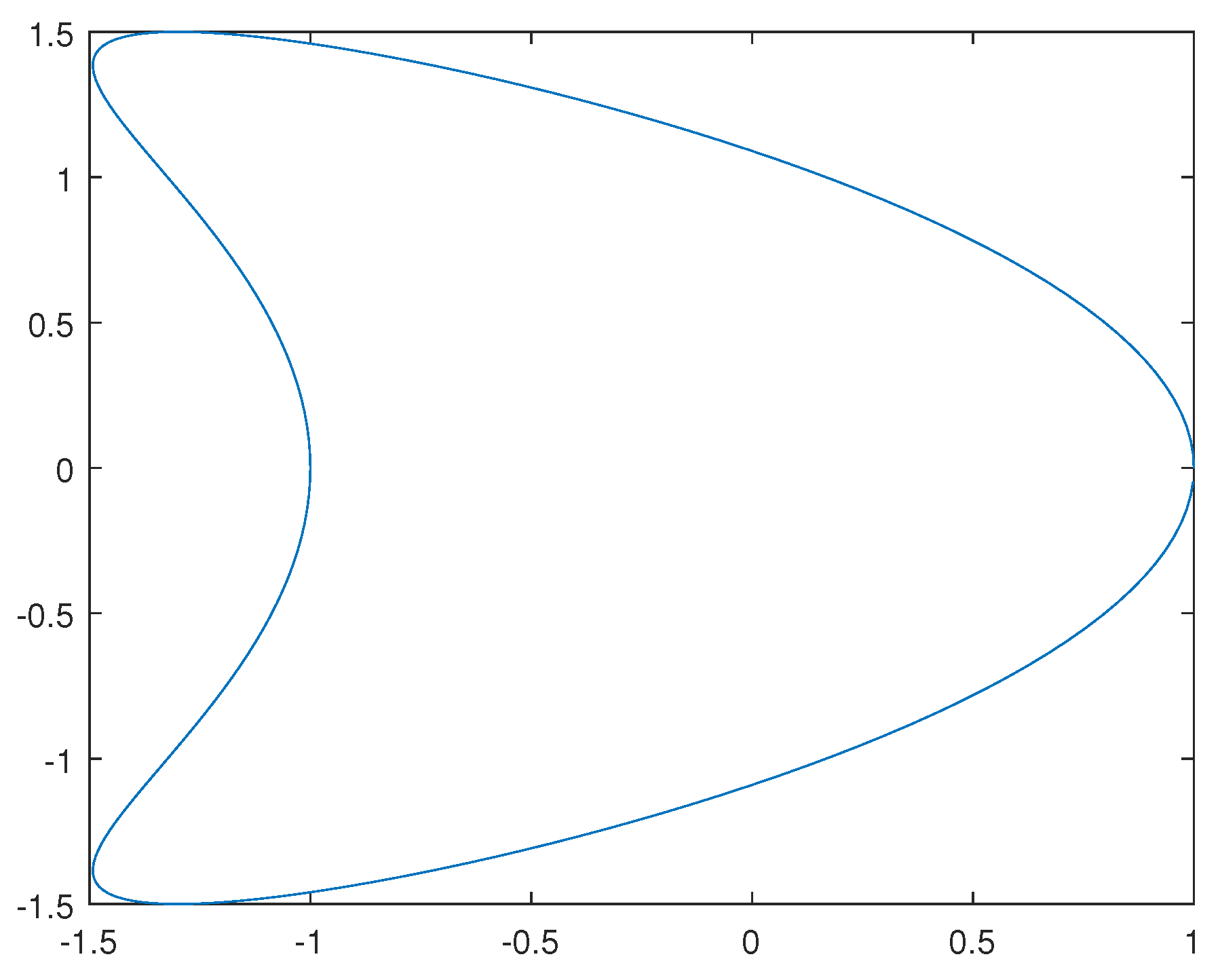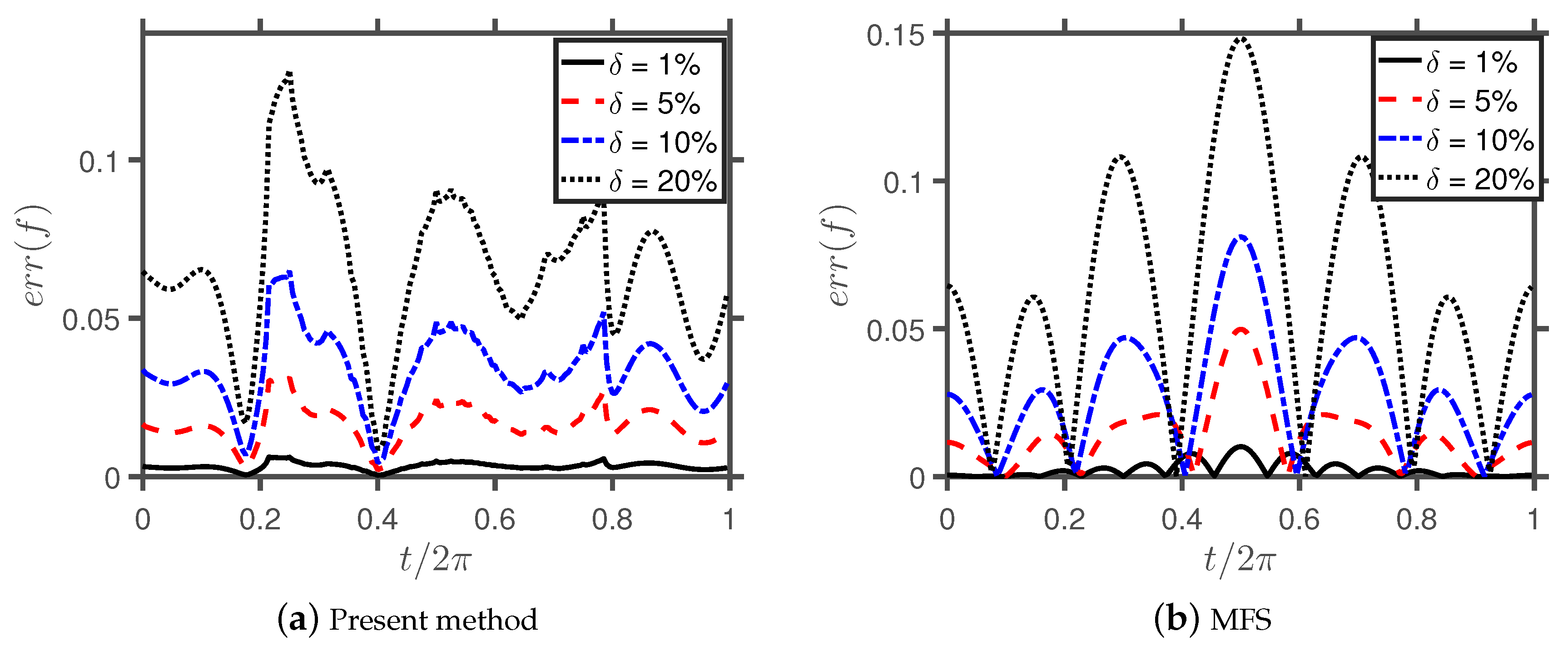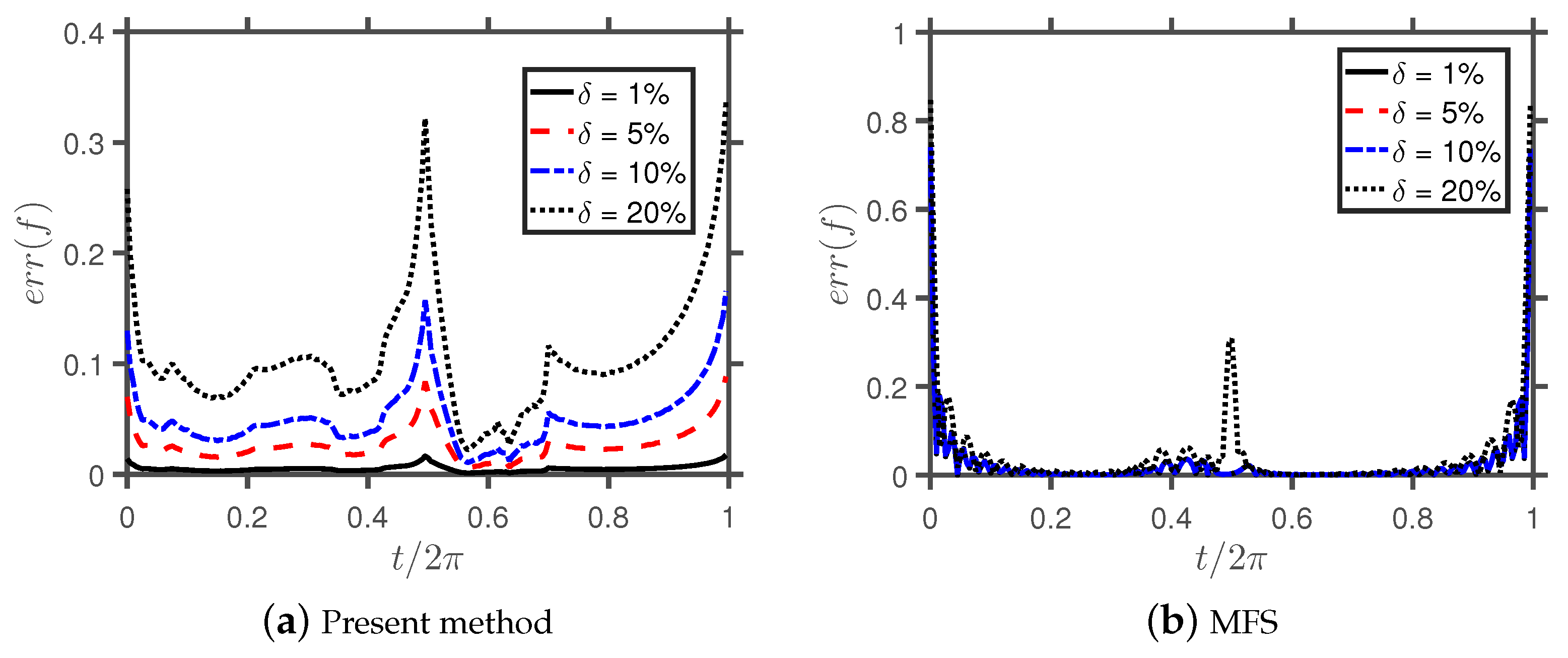A Numerical Method for Filtering the Noise in the Heat Conduction Problem
Abstract
1. Introduction
2. Mathematical Formulation and the Solution Method
3. Regularization Method
- Set , and give an initial regularization parameter ;
- Get from ;
- Get , from ;
- Get and byandrespectively.
- Set . If , end. Else, set and return to 2.
4. Numerical Examples and Discussion
5. Conclusions
Author Contributions
Funding
Conflicts of Interest
References
- Gu, Y.; He, X.; Chen, W.; Zhang, C. Analysis of three-dimensional anisotropic heat conduction problems on thin domains using an advanced boundary element method. Comput. Math. Appl. 2018, 75, 33–44. [Google Scholar] [CrossRef]
- Wang, F.; Chen, W.; Qu, W.; Gu, Y. A BEM formulation in conjunction with parametric equation approach for three-dimensional Cauchy problems of steady heat conduction. Eng. Anal. Bound. Elem. 2016, 63, 1–14. [Google Scholar] [CrossRef]
- Wang, F.; Hua, Q.; Liu, C. Boundary function method for inverse geometry problem in two-dimensional anisotropic heat conduction equation. Appl. Math. Lett. 2018, 84, 130–136. [Google Scholar] [CrossRef]
- Sun, Y. Indirect boundary integral equation method for the Cauchy problem of the Laplace equation. J. Sci. Comput. 2017, 71, 469–498. [Google Scholar] [CrossRef]
- Lee, J.W.; Chen, J.T.; Leu, S.Y.; Kao, S.K. Nullfield BIEM for solving a scattering problem from a point source to a two-layer prolate spheroid. Acta Mech. 2014, 225, 873–891. [Google Scholar] [CrossRef]
- Li, J.; Chen, W.; Qin, Q.; Fu, Z. A modified multilevel algorithm for large-scale scientific and engineering computing. Comput. Math. Appl. 2019, 77, 2061–2076. [Google Scholar] [CrossRef]
- Li, J.; Chen, W.; Fu, Z.; Qin, Q. A regularized approach evaluating the near-boundary and boundary solutions for three-dimensional Helmholtz equation with wideband wavenumbers. Appl. Math. Lett. 2019, 91, 55–60. [Google Scholar] [CrossRef]
- Li, J.; Fu, Z.; Chen, W.; Liu, X. A dual-level method of fundamental solutions in conjunction with kernel-independent fast multipole method for large-scale isotropic heat conduction problems. Adv. Appl. Math. Mech. 2019, 11, 501–517. [Google Scholar] [CrossRef]
- Marin, L.; Lesnic, D. Boundary element solution for the Cauchy problem in linear elasticity using singular value decomposition. Comput. Methods. Appl. Mech. Eng. 2002, 191, 3257–3270. [Google Scholar] [CrossRef]
- Chen, J.T.; Chang, Y.L.; Kao, S.K.; Jian, J. Revisit of indirect boundary element method: Sufficient and necessary formulation. J. Sci. Comput. 2015, 65, 467–485. [Google Scholar] [CrossRef]
- Hong, H.K.; Chen, J.T. Derivations of integral equations of elasticity. J. Eng. Mech. ASCE 1998, 114, 1028–1044. [Google Scholar] [CrossRef]
- Chen, J.T.; Lin, S.R.; Chen, K.H. Degenerate scale problem when solving Laplace’s equation by BEM and its treatment. Int. J. Numer. Meth. Eng. 2005, 62, 233–261. [Google Scholar] [CrossRef]
- Chen, J.T.; Lee, Y.T.; Chang, Y.L.; Jian, J. A self-regularized approach for rank-deficiency systems in the BEM of 2D Laplace problems. Inverse Probl. Sci. Eng. 2017, 25, 89–113. [Google Scholar] [CrossRef]
- Alves, C.J.S.; Valtchev, S.S. On the application of the method of fundamental solutions to boundary value problems with jump discontinuities. Appl. Math. Comput. 2018, 320, 61–74. [Google Scholar]
- Marin, L. An invariant method of fundamental solutions for two-dimensional steady-state anisotropic heat conduction problems. Int. J. Heat Mass Transf. 2016, 94, 449–464. [Google Scholar] [CrossRef]
- Sun, Y. A meshless method based on the method of fundamental solution for solving the steady-state heat conduction problems. Int. J. Heat Mass Transf. 2016, 97, 891–907. [Google Scholar] [CrossRef]
- Lin, J.; Liu, C.S.; Chen, W.; Sun, L. A novel Trefftz method for solving the multi-dimensional direct and Cauchy problems of Laplace equation in an arbitrary domain. J. Comput. Sci. 2018, 17, 275–302. [Google Scholar] [CrossRef]
- Liu, C.S.; Wang, F.; Gu, Y. Trefftz energy method for solving the Cauchy problem of the Laplace equation. Appl. Math. Lett. 2018, 79, 187–195. [Google Scholar] [CrossRef]
- Fu, Z.; Xi, Q.; Chen, W.; Cheng, A.H. A boundary-type meshless solver for transient heat conduction analysis of slender functionally graded materials with exponential variations. Comput. Math. Appl. 2018, 76, 760–773. [Google Scholar] [CrossRef]
- Feng, W.Z.; Gao, L.F.; Du, J.M.; Qian, W.; Gao, X.W. A meshless interface integral BEM for solving heat conduction in multi-non-homogeneous media with multiple heat sources. Int. Commu. Heat Mass Transf. 2019, 104, 70–82. [Google Scholar] [CrossRef]
- Fu, Z.; Xi, Q.; Ling, L.; Cao, C. Numerical investigation on the effect of tumor on the thermal behavior inside the skin tissue. Int. J. Heat Mass Transf. 2017, 108, 1154–1163. [Google Scholar] [CrossRef]
- Gu, Y.; Hua, Q.; Zhang, C.; He, X. The generalized finite difference method for long-time transient heat conduction in 3D anisotropic composite materials. Appl. Math. Model. 2019, 71, 316–330. [Google Scholar] [CrossRef]
- Li, J.; Chen, W.; Qin, Q.; Fu, Z. A modified dual-level fast multipole boundary element method for large-scale three-dimensional potential problems. Comput. Phys. Commun. 2018, 233, 51–61. [Google Scholar] [CrossRef]
- Gawronska, E.; Sczygiol, N. Application of mixed time partitioning methods to raise the efficiency of solidification modeling. In Proceedings of the 12th International Symposium on Symbolic and Numeric Algorithms for Scientific Computing (SYNASC 2010), Timisoara, Romania, 23–26 September 2010; pp. 99–103. [Google Scholar]
- Dyja, R.; Gawronska, E.; Grosser, A. Numerical Problems Related to Solving the Navier-Stokes Equations in Connection with the Heat Transfer with the Use of FEM. Procedia Eng. 2017, 177, 78–85. [Google Scholar] [CrossRef]
- Chen, W.; Fu, Z.; Wei, X. Potential problems by singular boundary method satisfying moment condition. CMES-Comp. Model. Eng. 2009, 54, 65–85. [Google Scholar]
- Gu, Y.; Gao, H.; Chen, W.; Liu, C.; Zhang, C.; He, X. Fast-multipole accelerated singular boundary method for large-scale three-dimensional potential problems. Int. J. Heat Mass Transf. 2015, 90, 291–301. [Google Scholar] [CrossRef]
- Gu, Y.; Chen, W.; Zhang, C.; He, X. A meshless singular boundary method for threedimensional inverse heat conduction problems in general anisotropic media. Int. J. Heat Mass Transf. 2015, 84, 91–102. [Google Scholar] [CrossRef]
- Wang, F.; Chen, W.; Hua, Q. A simple empirical formula of origin intensity factor in singular boundary method for Hausdorff derivative Laplace equations. Comput. Math. Appl. 2018, 76, 1075–1084. [Google Scholar] [CrossRef]
- Zheng, B.; Lin, J.; Chen, W. Simulation of heat conduction problems in layered materials using the meshless singular boundary method. Eng. Anal. Bound. Elem. 2019, 100, 88–94. [Google Scholar] [CrossRef]
- Chen, B.; Sun, Y.; Zhuang, Z. Method of fundamental solutions for a Cauchy problem of the Laplace equation in a half-plane. Bound. Value Probl. 2019, 2019, 34. [Google Scholar] [CrossRef]
- Young, D.L.; Tsai, C.C.; Chen, C.W.; Fan, C.M. The method of fundamental solutions and condition number analysis for inverse problems of Laplace equation. Comput. Math. Appl. 2008, 55, 1189–1200. [Google Scholar]
- Garabedian, P.R. Partial Differential Equations; American Mathematical Society: Providence, RI, USA, 1998. [Google Scholar]
- Kirsch, A. An Introduction to the Mathematical Theory of Inverse Problems; Springer: New York, NY, USA, 1996. [Google Scholar]
- Sun, Y.; Zhang, D.; Ma, F. A potential function method for the Cauchy problem of elliptic operators. J. Math. Anal. Appl. 2012, 395, 164–174. [Google Scholar] [CrossRef][Green Version]
- Kress, R. Linear Integral Equations, 3rd ed.; Springer: Berlin/Heidelberg, Germany, 2014. [Google Scholar]
- Sun, Y. Modified method of fundamental solutions for the Cauchy problem connected with the Laplace equation. Int. J. Comput. Math. 2014, 91, 2185–2198. [Google Scholar] [CrossRef]
- Chai, Y.; Gong, Z.; Li, W.; Li, T.; Zhang, Q.; Zou, Z.; Sun, Y. Application of smoothed finite element method to two-dimensional exterior problems of acoustic radiation. Int. J. Comput. Methods 2018, 15, 1850029. [Google Scholar] [CrossRef]
- Chen, J.T.; Chen, K.H.; Chen, I.L.; Liu, L.W. A new concept of modal participation factor for numerical instability in the dual BEM for exterior acoustics. Mech. Res. Commun. 2003, 30, 161–174. [Google Scholar] [CrossRef]
- Luan, T.; Sun, Y.; Zhuang, Z. A meshless numerical method for time harmonic quasi-periodic scattering problem. Eng. Anal. Bound. Elem. 2019, 104, 320–331. [Google Scholar] [CrossRef]
- Lin, J.; Zhang, C.; Sun, L.; Lu, J. Simulation of seismic wave scattering by embedded cavities in an elastic half-plane using the novel singular boundary method. Adv. Appl. Math. Mech. 2018, 10, 322–342. [Google Scholar] [CrossRef]









| Noise Level | |||
|---|---|---|---|
| Example 1 | |||
| Example 2 | |||
| Example 3 | |||
| Noise Level | Err(MFS) | Err(PM) | |||
|---|---|---|---|---|---|
| Example 4 | |||||
| Example 5 | |||||
© 2019 by the authors. Licensee MDPI, Basel, Switzerland. This article is an open access article distributed under the terms and conditions of the Creative Commons Attribution (CC BY) license (http://creativecommons.org/licenses/by/4.0/).
Share and Cite
Sun, Y.; Wei, X.; Zhuang, Z.; Luan, T. A Numerical Method for Filtering the Noise in the Heat Conduction Problem. Mathematics 2019, 7, 502. https://doi.org/10.3390/math7060502
Sun Y, Wei X, Zhuang Z, Luan T. A Numerical Method for Filtering the Noise in the Heat Conduction Problem. Mathematics. 2019; 7(6):502. https://doi.org/10.3390/math7060502
Chicago/Turabian StyleSun, Yao, Xiaoliang Wei, Zibo Zhuang, and Tian Luan. 2019. "A Numerical Method for Filtering the Noise in the Heat Conduction Problem" Mathematics 7, no. 6: 502. https://doi.org/10.3390/math7060502
APA StyleSun, Y., Wei, X., Zhuang, Z., & Luan, T. (2019). A Numerical Method for Filtering the Noise in the Heat Conduction Problem. Mathematics, 7(6), 502. https://doi.org/10.3390/math7060502





